Spanish is the most popular A-level language in schools across England for the fourth year running
The British Council presented today the results of the Language Trends England 2023 report.
- For the fourth year running, Spanish continues to have the highest number of A-level entries.
- Official exam data show that, for the fourth year running, Spanish is the most popular language at A-level, replacing the long-standing tradition of French being in the top spot. The diverging trends noted in the graph below would suggest that Spanish now has the highest A-level entries and it is predicted that this trend will continue in future cohorts. It is interesting to recall that French continues to be the most taught language in primary schools.

- The three most popular languages on the school curriculum in England are French, German and Spanish.

- French continues to be the most popular language at Key Stage 3 (ages 11-14), taught in 87 per cent of responding state schools and 97 per cent of responding independent schools, followed closely by Spanish in 75 per cent and 93 per cent of state and independent schools respectively.
- French, German and Spanish remain the ‘big 3’ curricular languages; with planned revisions to the GCSE specifications in these languages to take place from 2024, there are exciting times ahead in the study and research of future language trends in England.
Read the whole Language Trends England 2023 report here.
El español sigue creciendo y roza los 500 millones de hablantes nativos, según el anuario 2022 del Instituto Cervantes

El uso y conocimiento del español sigue creciendo en todo el mundo: roza los 500 millones de hablantes nativos (496,5 millones, casi cuatro más que hace un año) y está cerca de los 600 millones (en concreto, 595, cuatro más que en 2021) si se suma quienes tienen competencia limitada y los estudiantes. Son datos contenidos en El español en el mundo. Anuario del Instituto Cervantes 2022, que la institución encargada de promover nuestra lengua y nuestra cultura presentó este miércoles en su sede central.
Contenido completo del anuario 2022.
El director del Cervantes, Luis García Montero, dijo en la presentación de esta 23. ª edición que son «datos optimistas que nos comprometen a trabajar, pero no a la autocomplacencia», y que las «interesantes conclusiones y aportaciones de futuro» contenidas en el anuario nos ayudan a «tomar conciencia de la importancia de nuestra lengua».
A continuación, la directora Académica del Instituto, Carmen Pastor Villalba, mantuvo un coloquio con David Fernández Vítores, profesor de la Universidad de Alcalá, y German Rigau i Claramunt, subdirector del Centro Vasco de Tecnología de la Lengua (HiTZ).
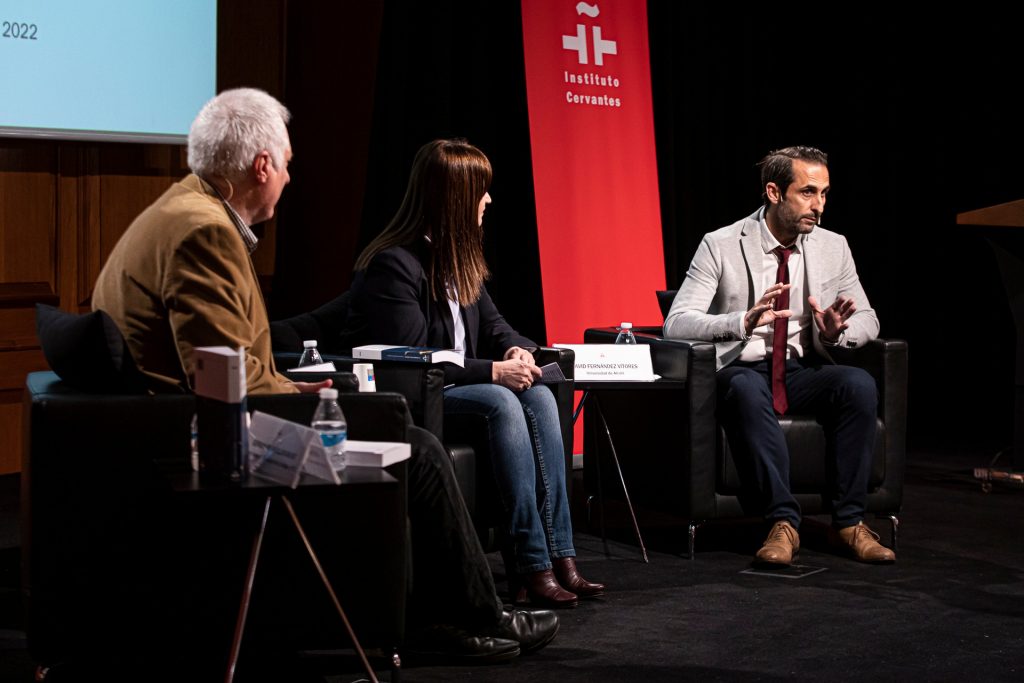
Este es el resumen de los principales datos de la principal publicación especializada del Instituto Cervantes, obra de referencia para investigadores, filólogos, profesores de español e hispanistas en todo el mundo:
• Más de 496 millones de personas tienen el español como lengua materna (tres millones más que en 2021), el 6,3 % de la población mundial.
• Los usuarios potenciales (hispanohablantes nativos más usuarios de competencia limitada y aprendices de lengua extranjera) superan los 595 millones (cuatro millones más que el pasado año), lo que supone el 7,5 % de la población mundial.
• El español es la segunda lengua materna del mundo por número de hablantes, tras el chino mandarín.
• Es la cuarta lengua en el cómputo global de hablantes (dominio nativo + competencia limitada + estudiantes), después del inglés, el chino mandarín y el hindi.
• El número de hispanohablantes seguirá creciendo en las próximas cinco décadas, aunque su peso relativo disminuirá de manera progresiva de aquí a final de siglo.
• En 2060, Estados Unidos será el segundo país hispanohablante del mundo, después de México. El 27,5 % de los estadounidenses serán de origen hispano.
• Casi 24 millones de personas (en concreto, 23.748.298) estudian español como lengua extranjera. La Covid-19 ha provocado una leve disminución de alumnos, con el sector del turismo idiomático especialmente golpeado, pero repunta el número de aprendices en páginas web dedicadas al aprendizaje autónomo.
• Estados Unidos sigue siendo el país con mayor número de estudiantes de español, que triplica el de estudiantes del resto de idiomas juntos.
Influencia económica y comercial del español
• Los hablantes de español tienen un poder de compra conjunto del 9 % del PIB mundial.
• Si la comunidad hispana de Estados Unidos fuera un país independiente, su economía sería la séptima más grande del mundo, por delante de la española y la francesa.
• En el conjunto de países donde el español es el idioma oficial o mayoritario se genera el 6,2 % del PIB mundial.
• Es el segundo idioma más relevante en el sector del turismo idiomático.
• El español como instrumento de comunicación internacional
• El idioma español es el tercero más usado en la Organización de las Naciones Unidas y el cuarto en la Unión Europea.
• Casi el 40 % de los alumnos de español se encuentran en países donde el inglés es lengua oficial o cooficial.
• El estudio de español es especialmente intenso en los dos principales países anglófonos: Estados Unidos y el Reino Unido.
• El español es la lengua más utilizada en los organismos de integración americana e iberoamericana.
Divulgación científica en español
• El español es la lengua en la que más textos de carácter científico se publican después del inglés.
• El 4,4 % de la producción científica tiene su origen en algún país hispanohablante.
• Casi el 70 % de los documentos científicos del ámbito hispanohablante se publican en España.
• El 72 % de la producción científica en español se reparte entre tres áreas temáticas principales: ciencias sociales (44 %), ciencias médicas (15 %) y artes y humanidades (13 %).
La lengua española en la red
• El 7,9 % de los usuarios de internet se comunica en español, que es la tercera lengua más utilizada en la red después del inglés y del chino.
• Más del 70 % de la población de países hispanohablantes tiene acceso a internet.
• Solo un país de habla española, México, se encuentra entre los diez con mayor número de usuarios en internet.
• En la mayoría de las plataformas digitales, como Facebook, LinkedIn, YouTube, Twitter, Wikipedia, etc., el español es la segunda lengua más utilizada.
• Los hispanos estadounidenses prefieren consumir y crear contenidos digitales en español en lugar de en inglés.
• En Estados Unidos, los usuarios de LinkedIn cada vez utilizan más el español como activo profesional fuera del ámbito hispanohablante.
Fernández Vítores destacó que, aunque aumenta la comunidad hispanohablante, se ha reducido el ritmo de crecimiento, en parte por el exceso de muertes (más de 1,5 millones) a raíz de la pandemia. El ciclo expansivo para el español terminará a mediados de siglo: no hay que «confiar solo en la demografía», apuntó, sino «generar contenidos valiosos y de calidad que interesen al ámbito no hispanohablante».
Spanish is the most popular A-level language for the second year in a row

For the first time, Spanish attracted over 100,000 GCSE entries – almost double the 2005 statistic – and was the most popular A-level language for the second year in a row. If current trends continue, the report predicts that Spanish is likely to overtake French as the most popular GCSE language by 2026, according to a new British Council report published today.
The Language Trends 2021 report surveyed teachers at more than 1500 primary, secondary and independent schools across England. The report, which has been published annually by the British Council for nearly twenty years, gathers information about language teaching and learning in England.
At Key Stage 3, Spanish is taught by 74 per cent of responding state schools and 89 per cent of responding independent schools.
To read the full report, please visit: https://www.britishcouncil.org/research-policy-insight/research-reports/language-trends-2021
Entrevista a nuestro estudiante en RNE
Entrevista al estudiante griego Lázaros Dallas, quien vive en Londres y estudia español desde 2017 en el Instituto Cervantes de Londres, en el programa Las mañanas de RNE con Pepa Fernández, en Radio Nacional de España (RNE).
«Spanish is such a useful language in today’s world»

We interview Elijah Berry, a 21-year-old student of Spanish and German at the University of Bristol. He recently completed his compulsory year abroad in Argentina and he is now studying his final year to graduate in 2021.
Berry recently won the Warwick Prize in Undergraduate Translation, with the translation of three texts from Spanish into English.
Why do you study Spanish?
I’ve studied Spanish since year 10 in secondary and I really enjoyed it all through GCSE and Alevel (it was one of my favourite subjects, I had a really good teacher and a lovely group of people in my class). I really believe that you should do something that you enjoy and so that is what I did. Spanish is also such a useful language in today’s world with so many speakers and learners.

What do I like most about it? What are biggest challenges?
I love that I can talk to people in their own language, rather than others always having to use English, I think it’s the best way to be able to understand other cultures and identities. Also being able to read Spanish language books, watch Spanish language movies and TV shows (there are some great ones out there) in their original language is very satisfying and I really get a lot out of it. Getting to learn about history, culture but also linguistics which I find really interesting and have only discovered during my time at university – but I love it! Translating is also a fun and unique aspect of language learning which I really like doing as well.
I think for me the biggest challenge is reaching and maintaining fluency – I’m still working my way there – but hopefully after some more time living in Spanish speaking countries, I will reach my goal.
What are my future plans in relation to Spanish?
Next year after graduation I am planning on doing a British Council Teaching Assistantship in either Ecuador or Spain. I am also interested in getting into the world of professional translation in the future. I definitely don’t want to lose my Spanish and I want to keep it up always! Spanish will always be important to me.

Spanish is the most popular language at A-levels for the first time, according to British Council Language Trends annual report
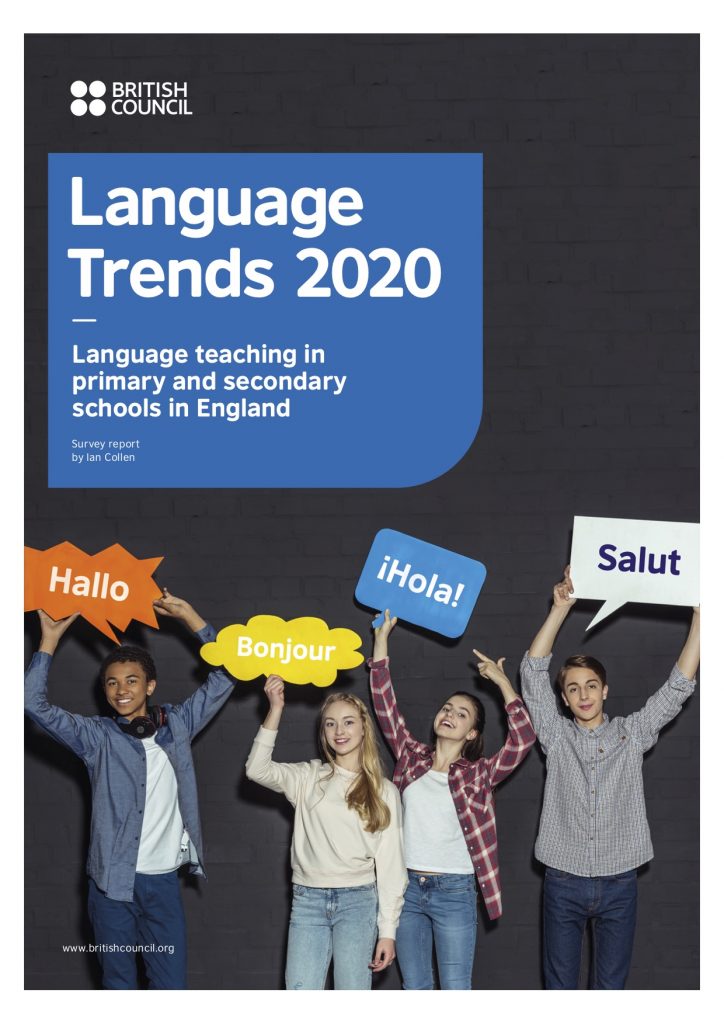
Spanish entries at A level exams in England have increased by almost 5% from 2018 making it the most popular language for the first time since A levels began. The records come from the Language Trends 2020 report which was published today by the British Council.
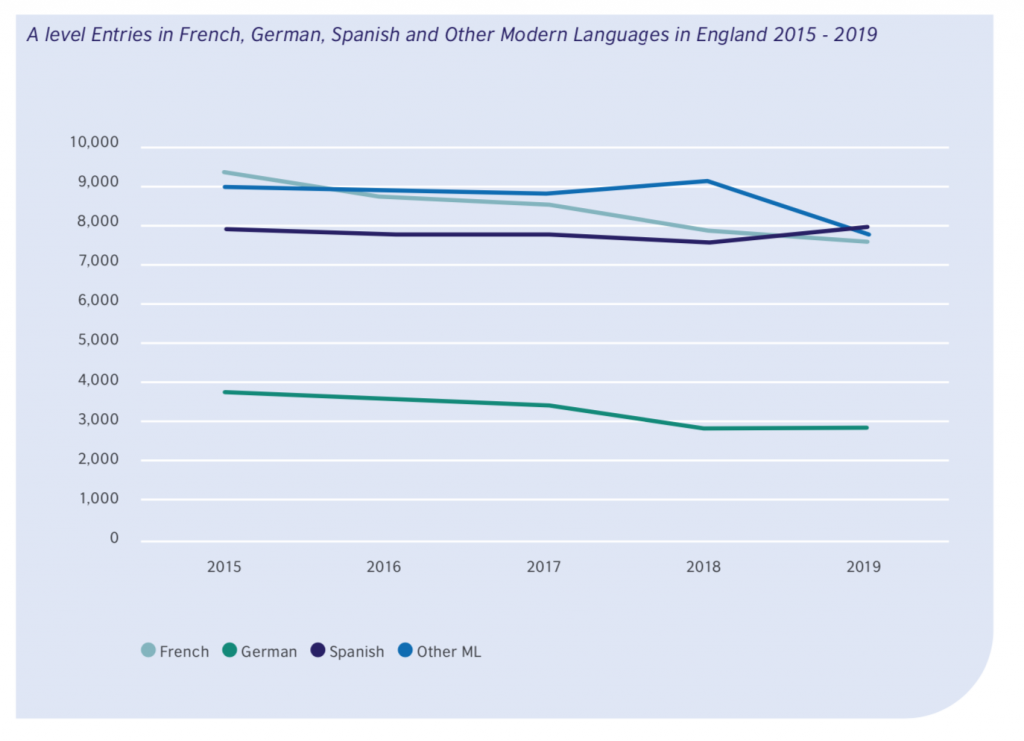
Between 2018 and 2019, entries for Spanish increased by 7.5% whilst French increased by almost 4%, according to official data on GCSE and A-level results from the Joint Council for Qualifications (JCQ). In total, 96.811 students took Spanish at GCSE in 2019 and 7.932 did the same at A-levels.
The annual report underlines that, “French looks set to be overtaken by Spanish as the most popular language by 2030, or earlier, if current trends continue,” using the data provided by the Joint Council for Qualifications (JCQ).
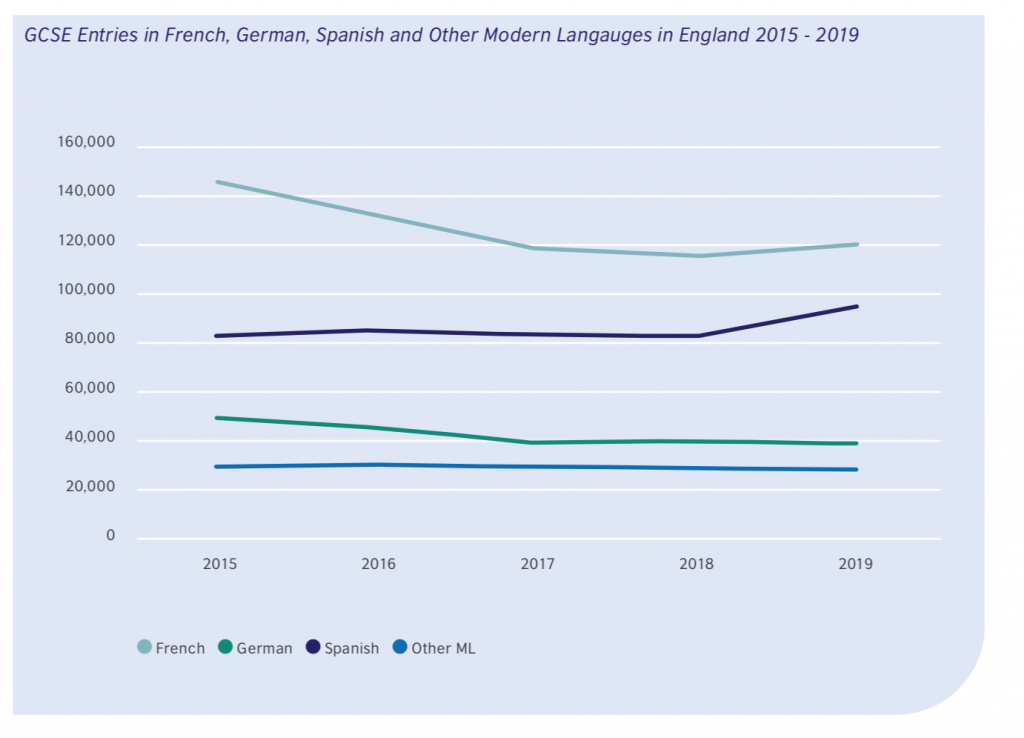
“The figures for studying foreign languages are still small, but the fact that Spanish takes the first position for the first time in history, is indicative of profound changes. These changes tell us about the growing weight of the Spanish-speaking world and its correlation in a country used to thinking globally, such as Great Britain,” said the director of the Instituto Cervantes in London, Ignacio Peyró.
Language Trends is an annual survey of primary and secondary schools in England designed to gather information about the situation for language teaching and learning. Its aims are to assess the impact of policy measures in relation to languages and to analyse strengths and weaknesses based both on quantitative evidence and on views expressed by teachers.
Instituto Cervantes and the British Council signed a Memorandum of Understanding in November 2019 with the aim of strengthening the bilateral dialogue and promoting “the joint work” so that each institution can “achieve its strategic results more effectively”.
El informe de lenguas del British Council confirma la primera posición del español en el bachillerato inglés

El español ocupa la primera posición en los exámenes del fin de bachillerato de Inglaterra, los llamados A-levels, con un aumento del 5% en 2019 respecto al año 2018, según los datos publicados hoy por el British Council en su informe anual Language Trends 2020.

Entre el año 2018 y el 2019, los estudiantes de español, tanto en los exámenes de A-levels (fin de bachillerato) como en los exámenes de GCSE, que se realizan al acabar el Key Stage 4 (la secundaria británica), aumentaron un 7,5 por ciento, frente al 4% de los que se decantaron por francés. El total de alumnos que se examinaron de español en GCSE en 2019 fue de 96.811 y de A-levels 7.932.
Además, el informe predice que el español “superará al francés como la lengua más popular en 2030, o antes, si las tendencias actuales continúan”, citando datos del Joint Council for Qualifications (JCQ, por sus siglas en inglés).

“Las cifras de estudio de lenguas extranjeras siguen siendo pequeñas, pero que el español ocupe la primera posición por primera vez en la historia es indicativo de cambios profundos. Cambios que nos hablan del peso creciente del mundo hispanohablante y su correlato en un país acostumbrado a pensar globalmente, como es Gran Bretaña”, aseguró el director del Instituto Cervantes de Londres, Ignacio Peyró.
El Language Trends es el estudio anual sobre tendencias de la docencia de lenguas extranjeras en Inglaterra, encargado por el British Council, y que proporciona datos sobre qué lenguas se enseñan en los centros de secundaria –tanto en los financiados con fondos públicos como en los centros privados– en las diferentes etapas educativas.
El Instituto Cervantes y el British Council firmaron en noviembre de 2019 su primer convenio de colaboración a escala global.
National translation competition for undergraduate students

We would like to draw your attention to a national translation competition for undergraduate students in Modern Languages in the UK, including those doing Spanish / Hispanic Studies.
The Warwick Prize in Undergraduate Translation aims to encourage students to engage with languages outside the classroom so that they can see that translation is a fun and creative activity which can be productive at all linguistic levels. See poster attached and below.
How does the Prize Work?
To enter, students will need to complete a translation portfolio. This portfolio will include:
- Translations of three set texts from EITHER French OR German OR Italian OR Spanish into English – available here.
- A critical reflection in English (300 words) on the translation approach.
- A completed entry form
To help students with their translations, the University of Warwick makes available on its website the webcasts of three translation workshops on (1) translation and song, (2) translation and theatre, and (3) translation and literature.
The set texts have been released on Thursday 7 May 2020 and entries can be submitted until 22 June 2020 at 5pm. The winners will be announced in Autumn 2020, with cash prizes for all the four languages.
Further information, including contact details and instruction for the submission of entries (via email only) can be found here.
The Warwick Prize in Undergraduate Translation is generously sponsored by the School of Modern Languages and Cultures, the German Academic Exchange Service (DAAD), the British Italian Society, and the Instituto Cervantes – London.
El Instituto Cervantes participa en The Language Show 2019 en Londres

El Instituto Cervantes de Londres participa del 15 al 17 de noviembre en la feria de las lenguas The Language Show, una cita anual en la capital londinense en la que se puede conocer toda la oferta de lenguas en los colegios y universidades, así como el amplio abanico de exámenes oficiales y actividad de cada uno de los centros culturales en Reino Unido.
“El Language Show es una oportunidad única de tener contacto directo con la oferta de enseñanza de lenguas que existe y para el Instituto Cervantes de Londres es el mejor escaparate anual para la difusión del centro en Reino Unido”, subraya el jefe de estudios del Instituto Cervantes de Londres, Pablo Martínez Gila.
Además, Martínez Gila destaca la cantidad de profesores de español que se acerca al stand para conocer las posibilidades de formación en Español como Lengua Extranjera (ELE), para actualizar conocimientos didácticos, metodológicos y lingüísticos.
 En su 31ª edición, The Language Show está considerado el evento de idiomas más grande de Europa, ofreciendo charlas, clases y funciones sobresalientes y tendrá 100 expositores, clases de prueba en 23 idiomas, charlas y seminarios gratuitos, entre otros.
En su 31ª edición, The Language Show está considerado el evento de idiomas más grande de Europa, ofreciendo charlas, clases y funciones sobresalientes y tendrá 100 expositores, clases de prueba en 23 idiomas, charlas y seminarios gratuitos, entre otros.
El Instituto Cervantes contará con un stand conjunto con la Consejería de Educación de la Embajada de España en Londres, en el que mostrará la oferta académica (clases y formación), cultural y de la biblioteca del centro, en una cita a la que acude desde hace más de 15 años.

Se trata una cita en el recinto ferial de Olympia, que todo aquel que esté aprendiendo o enseñando una lengua no se puede perder, ya que el visitante encontrará recursos, ayuda, consejos, formas de aprender y de enseñar, pero también inspiración y entretenimiento.
Consigue tu entrada gratuita para ir a The Language Show aquí.
Spanish, a language spoken by 580 million people, and 483 million of them native
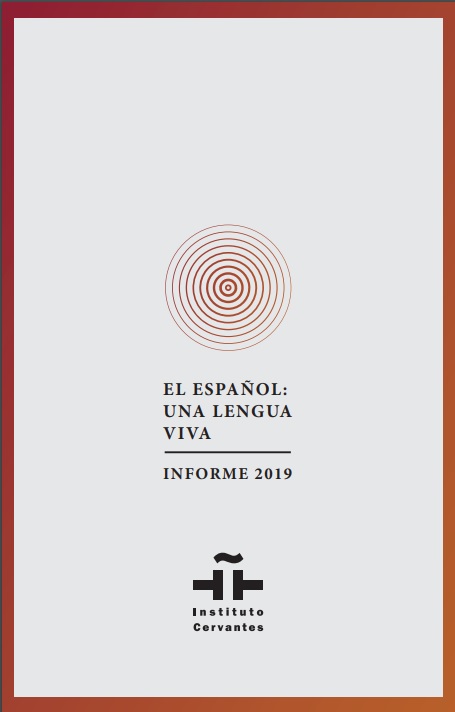
A total of 580 million people speak Spanish in the world, 7.6% of the world’s population. Of these, 483 million – three million more than a year ago – are native Spanish speakers, which makes Spanish the world’s second mother tongue by number of speakers. In addition, studies have shown that these 22 million people span across 110 countries. Spanish is the third most used language on the internet, where it has great growth potential.
Which is unfortunate, montreal online casino bids 100 Bonus Spins for the game Book of Dead from Playn GO are included in this welcome offer!
These are some of the most relevant data collected by the “Yearbook of Spanish in the world 2019”, done by Instituto Cervantes, presented by its director, Luis García Montero, accompanied by people who were in charge for its content, in an event open to the public.
David Fernández Vítores, author of the study, believes that Brexit will be positive for Spanish in the European Union because it will increase the proportion of Spanish speakers. His 90-page study offers an updated and very reliable census of Spanish speakers and contains «very positive and innovative data», such as the importance given to Spanish in the Linkedin network, a space that is analyzed here for the first time .
The first section of the book introduces the updated data on the Spanish language in areas such as demography, teaching and learning, Internet and social networks, science and culture, its international influence and economic value, as well as its diplomatic presence.
Demography:
Almost 483 million people have Spanish as their mother tongue. (The 2018 Yearbook estimated native speakers at 480 million).
The number of potential Spanish users exceeds 580 million. This figure brings together the groups of native domain, limited competence and foreign language students. Last year it was 577 million.
Spanish is the second mother tongue in the world by number of speakers, only behind Mandarin Chinese.
It is the third language in the global computation of speakers (native domain + limited proficiency + Spanish students) after English and Chinese.
7.6% of the world’s population is today Spanish-speaking. The percentage is expected to increase one tenth (7.7%) in 2050.
In 2100, this percentage is expected to fall to 6.6%, mainly due to the decline in inhabitants of Latin America in the face of the population explosion in several African countries, among other factors.
For demographic reasons, the percentage of the world’s population that speaks Spanish as a native language is increasing, while the proportion of Chinese, English and French speakers decreases.
In 2060, The United States is anticipated to be the second Spanish-speaking country in the world after Mexico: almost one in three Americans will be Hispanic.
Study of Spanish as a foreign language:
A total of 21,882,448 students study Spanish as a foreign language (67,000 more than last year), according to data recorded in 110 countries and at all levels of education.
The Cervantes Institute estimates that the real demand is 25% higher, since the data does not also reflect private education.
In the US, Spanish is the most studied language at all levels of education.
In the United Kingdom, Spanish is perceived as the most important language for the future.
In the European Union, France, Italy, United Kingdom and Germany (in this order) are the countries with the highest number of Spanish students.
The teaching of Spanish in English-speaking countries such as Canada (with 90,000 students), Ireland (47,000), Australia (34,000) and New Zealand (36,000) has also grown significantly.
Economy:
The contribution of all Spanish-speaking countries to global GDP (Gross Domestic Product) is 6.9%. A higher percentage than that generated by countries that have French as their official language.
In the case of Spanish, the common language multiplies by four bilateral exports among Spanish-speaking countries.
Spanish would be the fourth most powerful language in the world, slightly behind French and Chinese, and a great distance from English.
Spanish occupies the third position in the UN (United Nations Organization) and fourth in the scope of the European Union.
Spanish on the Internet:
It is the third most used language on the Internet after English and Chinese.
8.1% of internet communication occurs in Spanish.
It is the second most used language on Wikipedia, Facebook, Twitter and Linkedin. Of the 580 users of the Linkedin social network, 55 million use Spanish to a greater or lesser extent. Most of them (43 million), in Central and South America.
Spanish has a high potential for growth on the Internet due to the average internet availability in Spanish-speaking countries (which is 65.8%, still far from penetration in Spain, which exceeds 92%).
Mexico is among the ten countries with the highest number of users on the Internet.
Spanish in science and culture:
After English, Spanish is the second language in which most scientific documents are published.
Although the participation of Spanish-speaking countries in world scientific production has grown since 1996, Spanish scientific and technical research is relegated to a secondary level in the international arena.
Publishing Market:
Spain is the third largest exporter of books in the world, after the United Kingdom and the United States.
Two Spanish-speaking countries – Spain and Argentina – are among the top 15 book producers in the world, according to the International Publishers Association.
Spain occupies the eighth place in book production, and the ninth in the market value of the publishing sector.
Although the publication of books in electronic format is increasingly widespread, its market share is still low in Spanish-speaking countries.
READ THE FULL REPORT: «Yearbook of Spanish in the world 2019»




